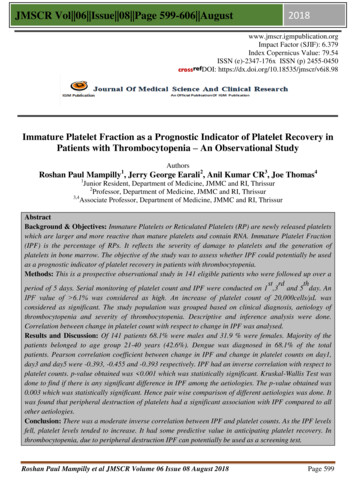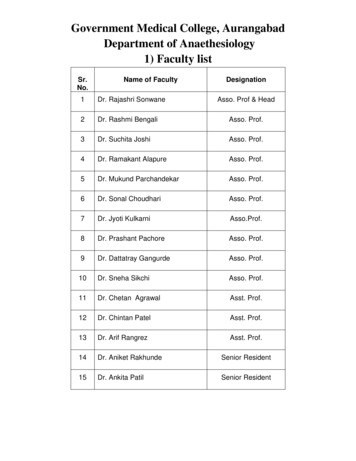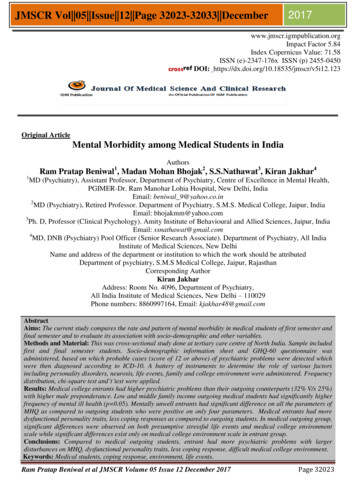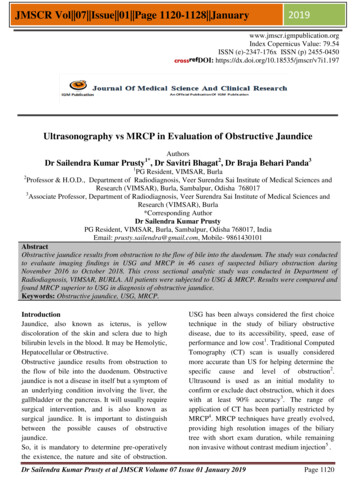
Transcription
JMSCR Vol 06 Issue 08 Page 599-606 August2018www.jmscr.igmpublication.orgImpact Factor (SJIF): 6.379Index Copernicus Value: 79.54ISSN (e)-2347-176x ISSN (p) 2455-0450DOI: https://dx.doi.org/10.18535/jmscr/v6i8.98Immature Platelet Fraction as a Prognostic Indicator of Platelet Recovery inPatients with Thrombocytopenia – An Observational StudyAuthors1Roshan Paul Mampilly , Jerry George Earali2, Anil Kumar CR3, Joe Thomas41Junior Resident, Department of Medicine, JMMC and RI, Thrissur2Professor, Department of Medicine, JMMC and RI, Thrissur3,4Associate Professor, Department of Medicine, JMMC and RI, ThrissurAbstractBackground & Objectives: Immature Platelets or Reticulated Platelets (RP) are newly released plateletswhich are larger and more reactive than mature platelets and contain RNA. Immature Platelet Fraction(IPF) is the percentage of RPs. It reflects the severity of damage to platelets and the generation ofplatelets in bone marrow. The objective of the study was to assess whether IPF could potentially be usedas a prognostic indicator of platelet recovery in patients with thrombocytopenia.Methods: This is a prospective observational study in 141 eligible patients who were followed up over ast rdthperiod of 5 days. Serial monitoring of platelet count and IPF were conducted on 1 ,3 and 5 day. AnIPF value of 6.1% was considered as high. An increase of platelet count of 20,000cells/μL wasconsidered as significant. The study population was grouped based on clinical diagnosis, aetiology ofthrombocytopenia and severity of thrombocytopenia. Descriptive and inference analysis were done.Correlation between change in platelet count with respect to change in IPF was analysed.Results and Discussion: Of 141 patients 68.1% were males and 31.9 % were females. Majority of thepatients belonged to age group 21-40 years (42.6%). Dengue was diagnosed in 68.1% of the totalpatients. Pearson correlation coefficient between change in IPF and change in platelet counts on day1,day3 and day5 were -0.393, -0.455 and -0.393 respectively. IPF had an inverse correlation with respect toplatelet counts. p-value obtained was 0.001 which was statistically significant. Kruskal-Wallis Test wasdone to find if there is any significant difference in IPF among the aetiologies. The p-value obtained was0.003 which was statistically significant. Hence pair wise comparison of different aetiologies was done. Itwas found that peripheral destruction of platelets had a significant association with IPF compared to allother aetiologies.Conclusion: There was a moderate inverse correlation between IPF and platelet counts. As the IPF levelsfell, platelet levels tended to increase. It had some predictive value in anticipating platelet recovery. Inthrombocytopenia, due to peripheral destruction IPF can potentially be used as a screening test.Roshan Paul Mampilly et al JMSCR Volume 06 Issue 08 August 2018Page 599
JMSCR Vol 06 Issue 08 Page 599-606 AugustIntroductionNormal platelet count is defined as, being between150,000-400,000cells/μL(1). Hence, thrombocytopenia can be defined as platelet count below150,000 cells/μL. Thrombocytopenia results fromdecreased marrow production, sequestration in anenlarged spleen and increased platelet destruction.Thus, the aetiology being multifactorial, causesmay be congenital, infective, drug induced andothers(1).In severe thrombocytopenia, where platelet levelsare 20,000cells/μL, the risk of morbidity andmortality increases dramatically. In severe cases,which can lead to life threatening haemorrhages(e.g. intracranial bleed), often the mode ofmanagement is platelet transfusion(2). However forcomplete disease resolution, it is important thatthere is revitalisation of platelet production.A recent advancement in this area has been theidentification of reticulated platelets or immatureplatelets. These are newly released platelets whichare larger and more reactive than mature plateletsand contain RNA. They are the platelet analogueof the red cell reticulocyte and are termed“reticulated” platelets (RPs).According to some studies on Immature PlateletFraction (IPF), the percentage of RPs reflects theseverity of damage to platelets and the generationof platelets in bone marrow(3) (4) (5) (6) (7). It helps indifferentiating between thrombocytopenia relatedto bone marrow dysfunction and umption . The normal range of IPF is 0.7 4.3%(4). In patients with bone marrowdysfunction, the IPF level remains low. Plateletrecovery in such patients is preceded by rise inIPF. However, in peripheral consumption ofplatelets, the IPF level remains high and a fall inperipheral destruction is followed by fall in IPF tonormal values. Therefore, the estimation of RP’scan reflect the rate of thrombopoiesis.The IPF levels can also predict the timing ofplatelet recovery which is within 1-2 days of IPFincrease(4)(5). Thus, serial assessment of RP’swould give a clearer picture about the progress of2018thrombocytopenia. In India, there are only a fewstudies on IPF and Platelet recovery and hencethere is need for such a study in the Indian setup,which takes into consideration thrombocytopeniaof different aetiologies.Materials & MethodsThis study was prospective observational studywith a sample size of 141, all of whom wereadmitted to the Department of Medicine, JubileeMission Medical College and Research Institute,Thrissur between December 2015&June 2016. Allcases of thrombocytopenia (platelet count of lessthan 1,50,000cellscells/µL) above thirteen yearsof age were included. All cases ofthrombocytopenia (platelet count of less than1,50,000cells/µL) below the age of thirteen yearsPatient’s details were collected at the time ofadmission and were grouped based on clinicaldiagnosis defined by clinical symptoms. The studygroup was also classified based on proposedpathophysiology into 1) predominantly bonemarrow suppression, 2) predominantly peripheraldestruction of platelets, 3) Both bone marrowsuppression and peripheral destruction 4)Abnormal pooling of platelets and 5) Unknowncauses. All the dengue cases were under group 3.The platelet counts and IPF were obtained usingSysmex XN 1000 Automated haematologystrdthanalyser at 1 , 3and 5 day followingadmission for each patient. An increase in plateletvalue of 20,000cells/ μL from the baseline wasconsidered as platelet recovery (4). IPF values of 6.1% was considered as a high IPF (5) and IPFvalue 6.1% was considered as low or normal.Data were entered in Microsoft Excel 2016 andanalysed in SPSS. Descriptive analysis wasinitially performed. This was followed byinference analysis where the association betweenchange in IPF and change in platelet values duringsubsequent days was done.Roshan Paul Mampilly et al JMSCR Volume 06 Issue 08 August 2018Page 600
2018JMSCR Vol 06 Issue 08 Page 599-606 3.1%0.0%6.3%1.0%2.1%Figure 1 Distribution of Clinical diagnosis in the male patients igure 2 Aetiology of thrombocytopenia of patients studiedFigure 3 Scatter plot showing non-linear relationship between Platelet counts and IPF on day 1Roshan Paul Mampilly et al JMSCR Volume 06 Issue 08 August 2018Page 601
2018JMSCR Vol 06 Issue 08 Page 599-606 AugustFigure 4 Scatter plot showing non-linear relationship between Platelet counts and IPF on day 3Figure 5 Scatter plot showing non-linear relationship between Platelet counts and IPF on day 5Table 1 Pearson correlation of IPF with Platelet on Day 1VariableIPF on Day 1n141Platelet on Day 1Correlation coefficient-0.454p Value 0.001Table 2 Pearson correlation of IPF with Platelet on Day 3VariableIPF on Day 3n141Platelet on Day 3Correlation coefficient-0.425p Value 0.001Table 3 Pearson correlation of IPF with Platelet on Day 5VariableIPF on Day 5n129Platelet on Day 5Correlation coefficient-0.412p Value 0.001Table 4 Pearson correlation of changes in IPF with changes in Platelet count between day 1 and day3VariableIPF Day 1- Day3Platelet Day1-Day3Correlation coefficientn141-0.394Roshan Paul Mampilly et al JMSCR Volume 06 Issue 08 August 2018p Value 0.001Page 602
2018JMSCR Vol 06 Issue 08 Page 599-606 AugustTable 5 Pearson correlation of changes in IPF with changes in Platelet count between day 1 and day 5VariablePlatelet Day1-Day5Correlationcoefficient-0.455n131IPF Day1-Day5p Value 0.001Table 6 Pearson correlation of changes in IPF with changes in Platelet count between day3 and day 5VariableIPF Day3-Day5Platelet Day3-Day5Correlationcoefficient-0.393n131p Value 0.001Table 7 IPF comparison according to Aetiology of Thrombocytopenia studied with respect to day 1, day 3and day5IPFBone marrowsuppressionDay 1Day 3Day 54.78 2.024.48 1.113.73 1.08Aetiology ThrombocytopeniaPeripheralBoth Bone marrowdestructionsuppression andperipheral destruction16.16 12.487.52 4.1213.71 11.927.80 4.4011.63 12.517.00 3.57p-valueAbnormalpoolingNotKnown6.71 6.247.01 6.777.40 7.396.50 2.746.21 2.855.68 2.26 0.0010.0010.015Table 8 Kruskal-Wallis test (One way ANOVA)ETIOLOGYBone marrow suppressionPeripheral DestructionBone marrow suppressionperipheral destructionAbnormal 7148.567p ValueSD2.02212.4800.0034.1226.2356.766Table 9 Pair wise comparisonAETIOLOGYBone marrow suppressionPeripheral DestructionBone marrow suppression andPeripheral DestructionResultsThe study included 141 subjects of which 68.1%were males and 31.9% were females. Majority ofpatients belonged to age group 21-40 years. (42.6%) Dengue was the most common clinicaldiagnosis in the study with 68.1% of the subjectsbeing diagnosed with the same. Subjects weregrouped into various clinical diagnosis whichPeripheral DestructionBone marrow suppression andPeripheral DestructionAbnormal PoolingBone marrow suppression andPeripheral DestructionAbnormal PoolingAbnormal ed dengue, leptospirosis, malaria, entericfever, sepsis, idiopathic thrombocytopenia,chronic liver disease, malignancy and druginduced thrombocytopenia (Figure 1).IPF was significantly high in the patients withIdiopathic Thrombocytopenic Purpura, mean was26.1% (9 to 48.8).Analysis of the data revealed an associationRoshan Paul Mampilly et al JMSCR Volume 06 Issue 08 August 2018Page 603
JMSCR Vol 06 Issue 08 Page 599-606 Augustbetween IPF and Platelet Levels with a p-value of 0.01. Analysis on Day 1, 3 and 5 levels of IPFand Platelets shows an inverse correlation with acorrelation coefficient (r) of -0.454, -0.425 and 0.412respectively. (Tables 1,2, and 3). Whenchange in IPF was compared with change inplatelets, it also showed a moderate negativecorrelation (Tables 3, 4 and 5).IPF is shown to have statistical significance whencompared to aetiology of thrombocytopenia.Theaetiological classification was based on theproposed pathophysiology of thrombocytopenia ineach clinical diagnosis. Kruskal-Wallis test (oneway ANOVA) which is a nonparametric test wasapplied to know if there was any significantdifference in IPF among the aetiologies ofthrombocytopenia (Table 8). The p- valueobtained was 0.003 which was statistically verysignificant. It showed that there was a significantdifference in IPF among the aetiologies. Furtheranalysis like pair wise comparison was donebetween all groups which showed that peripheraldestruction of platelets when compared with allother aetiology groups had a significant p-value(Table 9). The p-value was found to be 0.05which suggests that there is a significantassociation between IPF levels and plateletdestruction. In all other aetiologies p-value wasnot significant.DiscussionImmature Platelet Fraction (IPF) is a measure ofreticulated platelets found in the peripheralcirculation. It is a relatively new parameter whichcan potentially be used to assess the change inplatelet levels which could in turn be used toassess the prognosis of a thrombocytopenic state.This study aimed to find whether IPF can be usedas a prognostic indicator in thrombocytopenia.This study showed a moderate negativecorrelation between IPF and platelet. Thus, IPFhassomepredictivevalueindicatingcompensatory platelet production. This is inaccordance with previous studies by Abe et al(2006)(9), Saigo et al 2008(10) and Cremer et al20182009(11). In all these studies, a negative correlationwas established between IPF and platelets in bothadults and children.This relationship could be due to the phenomenoncalled immature platelet shift. This is similar toreticulocyte shift which is seen when moreimmature forms of reticulocytes are released intothe circulation as in anaemia. Thus, the time takenfor reticulocytes to lose their reticulum, the“reticulocyte lifespan” is increased(12)Cybulska et al found an inverse correlation wasfound between platelets and IPF levels in allaetiologies. This correlation was obtained in thispresent study as well. However, Cybulska et alalso found that there was a broad overlap ofimmature platelet measurements in ITP and bonemarrow failure patients. They concluded that IPFhas limited value in the diagnosis ofthrombocytopenia of different aetiologies(12).However in this study a significant associationbetween IPF levels and platelet destruction wasfound when compared to other aetiologies. In astudy by Pons et al(14), they had established a goodcorrelation between IPF and reticulated plateletsin thrombocytopenia due to peripheral destruction.A significant association between IPF and Denguewas not observed in our study despite denguebeing majority (68.1%). This may be due to thecoexistence of both bone marrow suppression andperipheral destruction in dengue fever (4) (13).However, in a study conducted by Dadu et al(2013) on Dengue patients found that IPF had astrong correlation with the recovery of plateletcounts(4)In other aetiologies like bone marrow suppressionand abnormal pooling, a statistically significantcorrelation was not obtained. This could bebecause the number of patients in both groupswere small. It may also be due to an overlap ofpathophysiology of thrombocytopenia in bonemarrow suppression and abnormal pooling.ConclusionsThere was a moderate inverse correlation betweenIPF and platelet recovery when all aetiologiesRoshan Paul Mampilly et al JMSCR Volume 06 Issue 08 August 2018Page 604
JMSCR Vol 06 Issue 08 Page 599-606 Augustwere considered. As IPF fell, platelets tend toincrease. In cases with peripheral destruction ofplatelets as an aetiology, there was a significantassociation with IPF. Hence further research needsto be conducted to study this association.IPF wasnot found to be a significant prognostic indicatorin dengue.References1. Konkle BA. Disorders of Platelet andVessel Wall. In Kasper DL, Hauser SL,Jameson JL, Fauci AS, Longo DL,Loscalzo J. Harrison's Principles ofInternal Medicine. Newyork: McGrawHill; 2015; 725.2. Watson HG, Craig JIO, Manson LM.Blood disease. In Walker BR, ColledgeNR, Ralston SH, Penman ID. Davidson’sPrinciples & Practice of Medicine. 22nded. Edinburgh: Churchill LivingstoneElselvier; 2014;1007-8.3. Briggs C, Kunka S, Hart D, Oguni S,Machin SJ. Assessment of an immatureplatelet fraction (IPF) in peripheralthrombocytopenia. British Journal ofHaematology. 2004 July; 126(1):93-9.4. Dadu T, Sehgal K, Joshi M, Khodaiji S.Evaluation of the immature plateletfraction as an indicator of platelet recoveryin dengue patients. International Journal ofLaboratory Hematology. 2014 October;36(5): 499-504.5. Suman F, D'Cruze L, Rajendran R,Varadarajan S. Dengue:platelet andimmature platelet dynamics a study doneat a tertiary care centre from South India.International Journal of recent trends inscience and technology. 2014; 12(3): 6203.6. De Blasi R, Cardelli P, Costante A, SandriM, Mercieri M, Arcioni R. Immatureplatelet fraction in predicting sepsis incritically ill patients. Intensive CareMedicine. 2013 April; 39(4):636-43.20187. Van der LN, Klinkenberg LJ, Meex SJ,Beckers EA, deWit NC, Prinzen L.Immature Platelet fraction measured onsysmex XN hemocytometer predictsthrombopoietic recovery after autologousstem cell transplantation. Eur J Haematol.2014; 93(2):150-6.8. Hulley SB, Browner WS,Newman TB.Estimating Sample Size and Power:Applications and Examples. In: Hully SB,Cummings SR, Browner WS, Grady DG,Newman TB, editors. Designing t Williams &Wilkins;2007;89.9. Abe Y, Wada H, Tomatsu H, Sakaguchi A,Nishioka J, Yabu Y, Onishi K. A simpletechnique to determine thrombopoiesislevel using immature platelet fraction(IPF). Thrombosis research. 2006;118:463-9.10. Saigo K, Sakota Y, Masuda Y, MatsunagaK, Takenokuchi M, Nishimura K,Sugimoto T, Sakurai K , Hashimotto M,Yanai T, Hayakawa A, Takeshima Y,Nomura T, Kubota Y, Kumagai S.Automatic detection of immature plateletsfor decision making regarding platelettransfusion indications for pediatricpatients. Transfusion and ApheresisScience. 2008; 38:127-32.11. Cremer M, Paetzold J, Schmalisch G,Hammer H, Loui A, Dame C, et al.Immature platelet fraction as novellaboratory parameter predicting the courseof neonatal thrombocytopenia. BritishJournal of Haematology. 2009 February;144(4):619-21.12. Cybulska A, Meintker L, Ringwald J,Krause SW. Measurements of immatureplatelets with haematology analysers are oflimited value to separate immunethrombocytopenia from bone marrowfailure. British Journal of Haematology.2017 May; 177(4): 612-9.13. Bhalla A, Bagga R, Dhaliwal L, Sharma R,Roshan Paul Mampilly et al JMSCR Volume 06 Issue 08 August 2018Page 605
JMSCR Vol 06 Issue 08 Page 599-606 August2018Varma S. Steroid responsive prolongedthrombocytopenia in dengue. IndianJournal of Medical Sciences Mumbai.2010 February; 64(2):90-3.14. Pons I, Monteagudo M, Lucchetti G,Munoz L, Perea G, Colomina I, et al.Correlation between immature plateletfractionandreticulatedplatelets.Usefulness in the etiology diagnosis ofthrombocytopenia. European Journal ofHaematology. 2010 August; 85(2):158-63.Roshan Paul Mampilly et al JMSCR Volume 06 Issue 08 August 2018Page 606
Roshan Paul Mampilly et al JMSCR Volume 06 Issue 08 August 2018 Page 600 JMSCR Vol 06 Issue 08 Page 2018599-606 August Introduction Normal platelet count is defined as, being between 150,000-400,000cells/μL(1). Hence, thrombocyto-penia can be defined as platelet count below 150,000 cells/μL. Thrombocytopenia results from










